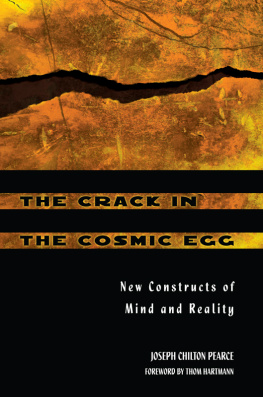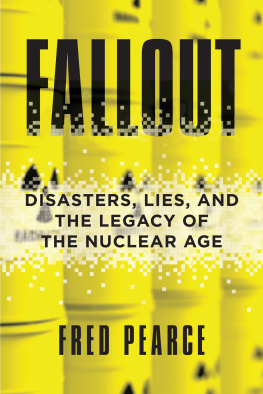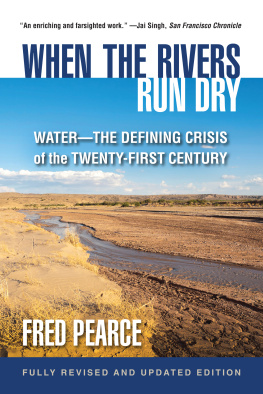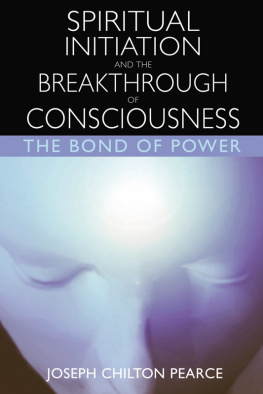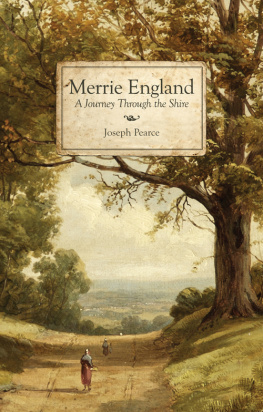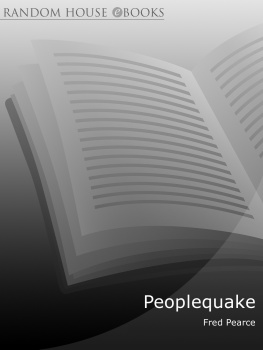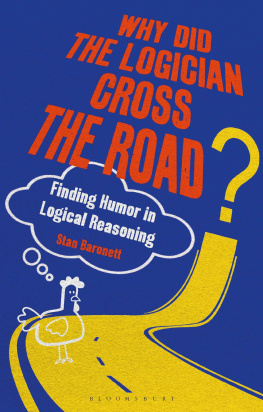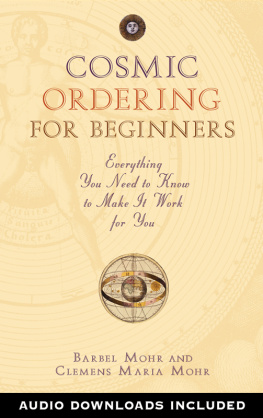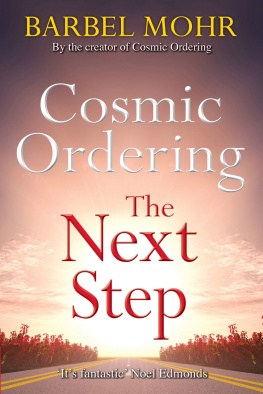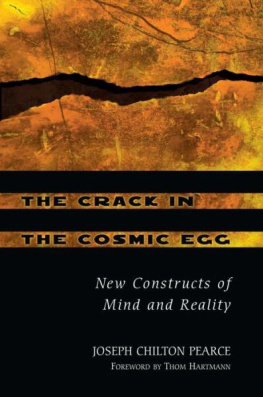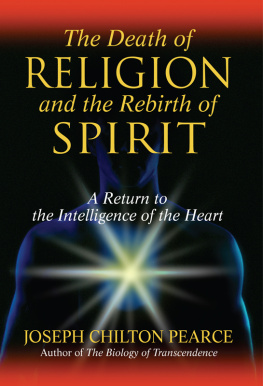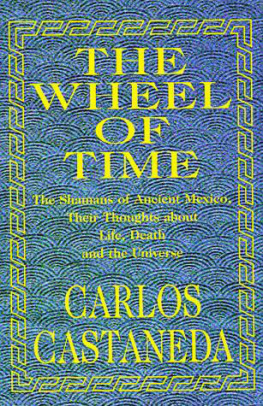THE CRACK IN THE COSMIC EGG
New Constructs of Mind and Reality
JOSEPH CHILTON PEARCE
Foreword by Thom Hartmann

To the memory of my wife,
Patricia Ann,
mother of our five

There was a child sent forth every day,
And the first object he looked upon, that object he became,
And that object became part of him for the day or
a certain part of the day,
Or for many years or stretching cycles of years.
WALT WHITMAN
foreword
by Thom Hartmann
I remember from when I was nine years old that there were two large mirrors facing each other on either side of the living room in my maternal grandmothers home. If I stood in just the right spot between them, I could look into either and see a seeming infinity of rooms and images of myself stretching off into an unfathomable distance. My maternal grandmotherone of my favorite people in the worlddied when I was nine, and I remember wondering if I were to spin around fast enough if I could catch a glimpse of her ghost, seeing her over my shoulder the way she used to stand with me as wed marvel at those infinite images when she was still alive.
The illusion of depth that the mirrors produced was startling in its apparent reality. Similarly, the world we live in has a tenacious sense of reality to it, as if solids were really solid and colors were really coloreven though we now know that solid objects are well over 99.9999 percent empty space and that colors are merely the vibration of tiny packets or quanta of electromagnetic energy we call photons, received in a chemical reaction in our retina and converted to electrochemical data for their transmission to our brain, where reality is assembled.
Even our culturemade entirely from the most ephemeral thoughts, ideas, and beliefshas a tenacious sense of reality to it. We know with great certainty whats possible and whats impossible, whats right and wrong, whats acceptable and whats offensiveeven though in the modern world all of these cultural referents change, often dramatically, through the course of a single lifetime. Still, at every moment each seems solid and real.
Weve discovered that there appear to be a few specific parts of the brain that, when activated in the right sequence and the right way, produce a sensation of awe and mystical union with all creation. Scientists have discovered that many religious rituals and techniques (and more than a few plants) fine-tuned by humans over millennia activate these parts of the brain in this way and can bring about a Buddha-like enlightenment or a St. Francis-like sense of mystical union. The fact that this sensation is perhaps part of the mystery of why every human society has a concept of divinity prominent in its culture is now openly discussed by neuroscientistsas is the deeper question of whether a conscious universe built this sequence into our brains so we could discover it, or whether our brains, when activated just right, produce a seeming reality of divinity out of neural impulses.
All of these are examples of the membrane of the reality in which we liveour egg, both personally and collectively. And the brain wiring that leads us to God, the discovery that matter is really mostly empty space, and that those mirrors arent doors into another dimension (or are they?), represent for me different aspects of the cracks we occasionally find or create in that egg.
One crack for me, in my early 20s, was first reading the book youre holding in your hands. And I wasnt alone in that experience back in the 1970s.
Classic is the word generally used to describe a work that is still fresh and relevant years after its first publication, be it written millennia ago like Platos dialogues, or centuries ago like the crisp and startling words of Thomas Jefferson or Teilhard de Chardin, or just three decades ago as was the first edition of The Crack in the Cosmic Egg.
Classics, in addition to having survived the years, are also viewed as such because theyve changed not just a few individual lives but entire cultural paradigms. With this book, Joseph Chilton Pearce introduced a crack into the egg of Western culture in the early 1970s that in many ways led directly to the more esoteric aspects of the modern self-help movement, the widespread interest in mysticism, and the discovery of the intersection of science and spirituality.
This is a life-changing book, and, as such, its worth taking in slowly and comfortably over some time. I remember it took me months to completely digest it the first time I read it, as I kept encountering concepts or ideas that I had to reality test, or discuss with others, or carry around, look at from different directions, talk with myself about, and even dream about before I could fully understand and integrate them into my life.
Theres so much in this marvelous book. For me, there were both discoveries and validations.
Consider, for example, Pearces description of the creative process. Ive been writing since I was old enough to read, and I have always thought it odd that Id get a vague idea or notion, and then would walk around with it for a few days or weeks or months (and in one case several years) feeling sort of like I was pregnant with something, but that it wasnt ready to birth. Id catch glimpses in daydreams, in synchronistic readings or discussions, in things I saw in the world. And then, suddenly, it would have to come out, and Id pick up a pad and pen or sit at my typewriter (and now my computer) and the words would all pour out, be they a poem or a story or the first draft of a non-fiction bookwith a clarity and precision and completeness that I never could have achieved if Id tried to assemble them step-by-step, word-by-word, or if Id tried to put them down on paper early in the process while I was still pregnant with the concept but not yet a-birthing. I discovered in this book that the way I write and the way others create is similar, that we become aware of the egg, and then a small crack in it, and thenby serendipity or magic or the grace of Godthe crack suddenly opens enough that the light of understanding flows in and its all just so clear and easy to express.
Pearces understanding of the many facets of the egg and its various cracks are shared by others, particularly those who have lived among the most ancient peoples of this world. My author and psychologist/sociologist friend Robert Wolff recently told me a story of his time spent with the indigenous Sngoi people of Malaysia, and how they would simply know things that had happened to other members of their tribe at remote locations, or things that were going to happen in the future, with an absolute and uncanny accuracy and certainty. The egg of Roberts western university (two Ph.D.s) training was cracked by his contact with these extraordinary hunter/gatherer people who lived in the jungle in perfect balance and peace with their environment and each other. Commenting on it, he wrote me a note in June of 2002 saying, Thom, we lost so much when we chose machines!
Indeed, as Pearce chronicles in this brilliant exploration, we have lost much. But, as you will also discover as you read this book, the primeval trail markers and runes, the cracks discovered by the ancients, are still whispering to us. And, perhaps equally exciting, the deeper we dig into an understanding of physics and the natural world, the more we are able to see clearly the outlines of the crack that the shamans and fire walkers told us about, and that modern physicists like David Bohm have demonstrated in the laboratory must exist.
Next page
